"Nothing that results in human progress is achieved with unanimous consent."
Christopher Columbus
"Nothing is more difficult than the art of maneuvering for advantageous positions"
Sun Tzu

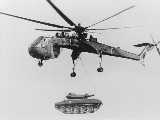
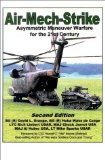
"Where was the cavalry? ...and I don't mean horses. I mean helicopters and light aircraft, to lift Soldiers armed with automatic weapons and hand-carried light anti-tank weapons, and also lightweight reconnaissance vehicles, mounting anti-tank weapons the equal or better than the Russian T-34s [Editor: today its T-72s, T-80s, T-90s]...If ever in the history of our armed forces there was a need for the cavalry arm--airlifted in light planes, helicopters and assault-type aircraft--this was it... Only by exploiting to the utmost the great potential of flight can we combine complete dispersion in the defense with the facility of rapidly massing for the counter-attack which today's and tomorrow's Army must possess"
---Lieutenant General James M. Gavin
Harper's magazine, 1954 in the aftermath of the Korean war
"Only the French Army had the foresight in 1946 to conceive a well-armed air-transportable tank- the AMX-13. Although too heavy for such tactical transports as the C-119 and C-123, and the French Nord 2501 Noratlas, the AMX has been carried successfully in the Bregurt 765 Saltara and is within the carrying capacity of such more recent transports as the C-130 Hercules and the British Lleucrlcy. Thus by the mid-fifties the AMX acquired the distinction of being the only battle-worthy air-transportable tank in service. It was only after the prototypes of the AMX appeared that the somewhat similar T92 air-transportable tank was designed in the United States. A little earlier came the 1949-specified T1O1 Airborne self-propelled gun, since standardized as the M56, at about the same time the Soviet Army also introduced into service an air-transportable 57mm self-propelled anti-tank gun."
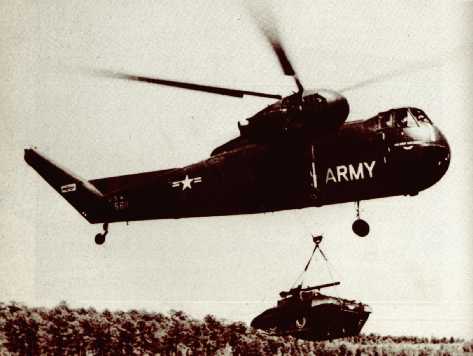
Here is a piston-engined CH-37 Mojave lifting the prototype of the tracked T92 or T101 Armored Reconnaissance Airborne Assault vehicle (AR/AAV) with a 106mm recoilless rifle (combat favorite) in the 1950s! Eventually the M56 Scorpion with 90mm gun was fielded in Airborne units in the '60s and went to Vietnam during the Tet offensive, but its gasoline propulsion and open top nature was unpopular. Certainly could have been Air-Meched by helicopter as well as Para-Mech by fixed-wing, however. The M56 Scorpion with 90mm gun which was used in combat in 1968 when the 82nd Airborne Division deployed to counter the Tet offensive.
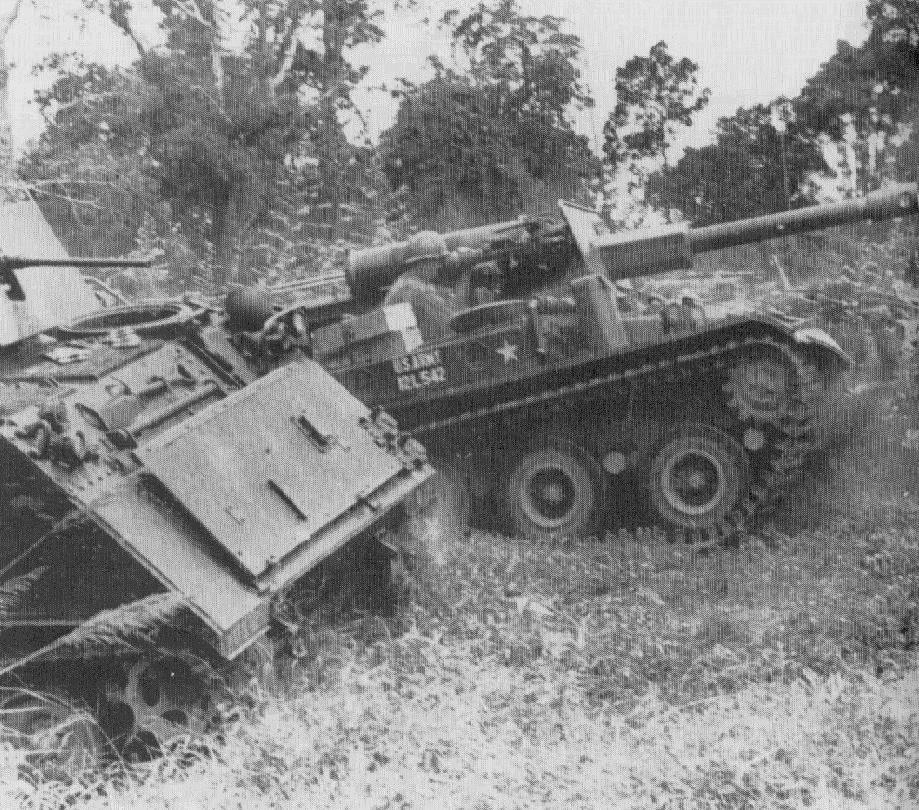

Sources:......
The Illustrated Encyclopedia of Military Vehicles, Ian V. Hogg and John Weeks.
War Machine Magazine, issue 13, An Illustrated Guide to Armoured Vehicles of the 1950s and 1960s. (Orbis 1983)
The Illustrated Encyclopedia of Artillery, Ian V. Hogg.
Basic information:
In service 1957, left service 1970, replaced by M551 Sheridan. Served only with 82nd and 101st Airborne Divisions (not with the marines, they had the M50 Ontos, which served the same role).
All welded and riveted aluminium construction, only armor being the gun-shield. Chassis based on M76 Otter, torsion bar suspension, steel reinforced rubber tracks. Four single roadwheels each side. Drive sprocket at front, idler at rear, no return rollers.
Power provided by Continental 6 cylinder horizontally-opposed petrol (gas) engine, 200 hp.
Speed: 28 mph, range 140 miles.
Weight: 7.03 tonnes. (Could of been heli-transported by CH-47 or CH-54s and/or parachute airdropped from fixed-wing C-130s)
Length: (with gun) 19ft 2in, length - hull 14ft 11.33in
Width: 8ft 5.5in
Height: 6ft 9.33 in.
Crew: 4
Gun: 90mm M54 with 29 rounds of AP-T, APC-T, HEAT, HEAT-T, HEP-T, WP, TP-T, HVAP-T or HVTP-T. The gun was served by a gunlayer and driver on the vehicle, with other crew standing on the ground. Effective range in A-T role was 2500M.
A few were supplied to South Korea, Spain and Morocco and they were used for fire support in Vietnam. The gun was too powerful for the chassis, upon firing the forward part of the vehicle lifted off the ground and the muzzle brake kicked up huge amounts of dust. Designed for air-dropping. Could be external-sling-loaded underneath CH-47 Chinook-type helicopters.
And there was the 106mm Recoilless Rifle mounted on jeeps and M274 MULE 4 x 4 vehicles used very effectively for shock action/anti-tank fires by the Airborne in the Dominican Republic and Vietnam.
"Urban forces must also be capable of insertion directly into the urban area or extraction from it using next-generation rotorcraft capable of transporting both personnel and their armored urban combat vehicles."
---Lieutenant Colonel Robert F. Hahn II:
http://carlisle-www.army.mil/usawc/Parameters/99summer/hahn.htm
LTC Hahn is the Director of the Army After Next Urban Warfare Project. He is assigned to the Office of the Deputy Chief of Staff for Doctrine, U.S. Army Training and Doctrine Command, Fort Monroe, Va., where he is also responsible for geopolitical and economic analysis on behalf of the Army After Next Project.
WHY Air-Mech-Strike?
Our intent is to "AIR-mechanize" armor not replace it. The close direct-fire fight is not going away soon, as Armored Fighting Vehicles are still needed to help infantry take/hold ground by providing shielded mobility, firepower and a mobile supply "mother" vehicle to carry large amounts of ammunition in order to "fight outnumbered and win". We learned in Vietnam that helicopters cannot linger in the target area to do this in the "death ground"; we need AFVs. As you can see above we could have had a combination of helicopters and Infantry/AFVs in Vietnam using either the M551 Sheridan light tank, the M56 Scorpion SP 90mm gun, the M50 Onto SP 6 x 106mm Recoilless Rifle vehicle, the M114 scout vehicle or the fantastic M113 APC with ACAV gunshields. If the under 8-ton but gas-powered M114s, M56s and M50 Ontos vehicles were considered too risky for combat due to fire hazards, then the heavier diesel-powered M551/M113 combination could have been used. If lift helicopters were inadequate qualitatively for the 17-ton M551 and 11-ton M113 or not enough in quantity, the Brigade of the 101st Airborne or 1st Cavalry Division still on jump-status could have parachuted after heavy-dropping their M551s/M113A3s from uSAF C-130 fixed-wing aircraft, working in concert with helicopter-delivered Air Assault infantry. The French certainly parachuted all over the Vietnames countryside in the first indo-China war, 1946-54. When the Air Cavalry fought in conjunction with the 11th ACR in M113 ACAVs and M48 medium tanks, the results were legendary successes. During the 1968 Tet offensive, these forces almost single-handedly defeated the VC attacks in the Saigon area by rapid operational maneuver that could fly over or go cross-country to avoid predictable enemy ambushes along roads that would have stopped 2-D wheeled forces. To combine the two into a stronger whole to avoid the pitfalls of direct delivering troops on foot by helicopter using the mobility of the AFV to open the range of insertion points (off-set delivery DZs/LZs) would transform the entire concept of 3-D Airborne/Air Assault maneuver warfare.
The heavy AFV, 2-D maneuver only close fight's dominance as the PRINCIPAL means of destroying large enemy mechanized formations we contend is over. Look at Desert Storm--other than the singular battle of 73 Easting, 80% of the enemy tanks killed were destroyed by indirect fires. The Precision Guided Munition, top-attack from extended ranges makes getting into firing position FIRST the number #1 requirement to victory.
The USS Missouri arrived in Pearl Harbor last month to take its place next to the Arizona as a WWII "Battleship Row" memorial. We spoke with some Naval officers who served on her during the Gulf War and they indicated that they had little to fear from Exocet or Silkworm anti-ship missiles because of the massive armor plate surrounding the 56,000 ton ship! Despite such sentiments, however, the Navy has no plans to return to "heavy armor" as a design plan for their future surface combatants. The huge sacrifice in cost (force structure) and endurance (power projection) is not justified for a protective feature that is so rarely put to the test if the battle is fought correctly. For naval gunfire support and "insurance" keep 2 of the Iowa class battleships we have in readiness, but within a context of a missile-dominated sea fight. The same thing is true for land warfare, the Army and marines just haven't realized it yet.
I know many would say "tell that to the Moms and Dads who have their sons and daughters who are in those vehicles crossing a desert plain." Well emotion aside, we feel strongly that the next generation of armored vehicles needs to be M113A3 size and weight and be married to a vertical lift aircraft that can provide Air Assault mobility so these vehicles GET INTO MISSILE FIRING POSITION FIRST BEFORE they are even in danger of getting hit by enemy direct-fire. Our "land battleships", the 70-ton M1 Abrams tank and 33-ton M2 Bradley Fighting Vehicle will still be needed for a portion of the 2-D fight, but the context of the land battle will be shaped by M113A3-sized light armored fighting vehicles (AFVs) which are fully air/ground 3-D agile with stealth features like dust skirts and electric drives to evade detection. The British helicoptered their infantry and armored fighting vehicles into Kosovo, bypassing, mine, road blocks, rough terrain, getting their as the first NATO ground forces. This success in contrast to our TF Hawk's bad publicity is instructional: the British have EXPANDED THEIR AIR-MECH CAPABILITY by fielding the 16th Air Landing Brigade!
http://www.army.mod.uk/army/organise/16_aaslt_bde/5Bdehst.htm
They have bought their own WAH-64 Apache helicopters and do not seem to have any of the too-hard-to-do mentalities we have had of late in the U.S.

CH-47F Sling-loading a M113A3 Gavin Fighting Vehicle (GFV)
Such Air-Mobility Vehicles (AMVs) would employ EFOGM, HELLFIRE and LOSAT type munitions and a large caliber cannon to primarily destroy fortifications/buildings with a secondary anti-AFV role.
Anything heavier would continue the WWII technologically handicapped philosophy of 2-D mechanized warfare, which was not terrain agile let alone 3-D AIR-MOBILE, but bridge and road dependant because it sought only a horizontal envelopment. Sometimes its simply not possible to break through or swing around an alert and entrenched enemy with mobility equal or superior to you---regardless of one's "situational awareness"---you will simply have a computer display saying you are blocked and stuck in a minefield. A tank stuck in a minefield with a computer is still a tank stuck in a minefield. In our mad embrace to adopt Tofflerian thinking we have forgotten we still live in a PHYSICAL WORLD where MECHANICAL ADVANTAGE counts, and this is not inferior "2d Wave, Industrial age" stuff. Mental is mental, physical is spiritual, and its always been this way. If one considers the failed British XXX Armored Corps break-out to the Arnhem Bridge held by Paratroopers dropped in ahead without their own light armored vehicles in 1944, "A Bridge too Far", you see a mini-version of the ultra-heavy and ultra-light feast/famine force structure mess the U.S. military is in now when it comes to mechanical advantage/operational maneuver--things that electronic gadgetry cannot fix. The current U.S. Army Chief of Staff, General Shinseki says he wants to change this, and get us a force that is Air-deliverable and light but can maneuver on its own. And this isn't a pathetically tiny bunch of foot-sloggers from a V-22 tilt-rotor or a pair driving in a sexy, unarmored dune buggy that can get toasted into a flaming wreck by the first burst of enemy small arms fire or artillery/mortar shrapnel because we THINK we can avoid enemy contact via electronic means and the oxymoron military intelligence. Sooner or later you have to stop dancing around the enemy and fight him, and you had better have armor protection to survive his automatic weapons, RPGs, rifle grenades--this means a light armored skin, not "rat patrol". And not fake armor like the unable-to-be-carried-by-helicopter-internally-McLAV armored car has. Today, we do not need to be handicapped by having to take bridges, we have light armored vehicles that can swim across water or be FLOWN OVER OBSTACLES to defeat enemies from an unexpected direction using VERTICAL ENVELOPEMENT. What we have to do is make a conscious effort to match the right light vehicles to their carrying aircraft, and insure the next generation of BOTH light AFVs and their carrying aircraft can work together to create AIR-Mech-Strike capabilities. The paradigm that needs to be broken is the assumed dominance of the direct-fire gun fight and its requirement for heavy armoring to survive it, which on a vehicle robs them of air-transport created mobility as well as ground agility for swimming or venturing far from the road net. It makes these medium/heavy "land mastadons" road/bridge dependant---Arnhem all over again. In contrast a perfect example of terrain-agile light AFVs saving the day was the Tet offensive in 1968; M113s with gun-shield protected machine guns were able to rapidly move into Tan Son Nhut airbase to save it from being over-run by several thousand enemy foot Soldiers by overwhelming protected firepower. These same vehicles flushed out the die-hard Viet Cong from Saigon, saving hundreds of American lives that would have been lost in infantry-pure assaults.
If we can make the transition away from the DF gun "crucible" like our Navy brethen, the possibilities are exciting! In the year 2020 we could field Army formations with regional self deployment capabilities:
Airborne Inchon:
Okinawa to North Korea in four to six hours! Mine warfare and land obstacles are not "show stoppers". An AIRmechanized Brigade forward deployed to Guam would quickly quiet things in a Spratly Island dispute. The timely deployment of light AFVs saves the day in a shooting war.
Air-MECHanized Desert Shield/Storm:
Even Diego Garcia could be used to project an AIRmechanized Brigade into SWA: a flexible, mobile area defense not a fatalistic "speed bump" line in the sand Desert Shield. Assuming the USAF controls the Air.....with their track record, that's a safe bet.
But if the Armor community fields another 50-ton "land battleship", they run the risk of being viewed as too expensive, too hard to move and not effective in other than open desert.
The U.S. Army After Next folks (AAN) are doing studies on the replacement for the 450 CH-47s we have in the inventory. It would be outstanding to have future Armor thinkers working hand in hand with this emerging design requirement so that the future AGS/FCS etc is completely compatible with the future heavy lift aircraft. Our sources say that this has not occurred. We should not miss this opportunity! We both know that the design requirement for equipment fielded in the year 2010-2020 must be done now, and with the fore thought that what ever we build we will be stuck with for 30 years after! Our grandchildren will either thank us or curse us in the year 2050!
Consider we have an entire Army equipped with the 70-ton hardware required to win in a Cold War fight against the evil empire. It was very short-sighted not to proceed with the AGS. We are strongly in favor of some light tracked/wheeled armor and have done what can be done to help move some of the Armored Force's thinking along those lines. We see a future with reinforced, digital combined arms Brigades/Regiments/Strike forces/whatever as the forces to reckon with rather than our current Heavy Divisional structures. We do not believe that aviation and FA fires alone, precision mumbo-jumbo notwithstanding, can or will win conflicts of the future-they might be able to if we were only going to fight on the plains south of Tehran or other such conventional places. We agree to some extent with LTC Ralph Peters (r) here, that the future sites of conflict will see us having to get in amongst the populace to weed out and neutralize the bad guys. You can only do that with guys and guns on the ground and in more than the "mop up" role currently envisioned by some in USAF circles (and I suspect in USA Aviation Brigades). If Armor isn't willing to change, its battlefield function is going to be supplanted by other branches and services who are better at political gamesmanship than we.
But its a huge mistake to wait until 2020 to AirMECHanize the U.S. Army when we need operational experience NOW using existing Army helicopters and off-the-shelf AMVs in at least a RSTA Squadron in the new Medium Brigade Combat Teams (BCTs).

AIR-MECHanized now: Gavins, Ridgways and Wiesels
The 82d Airborne Division: first to fight



"Col Alexander P. Shine writes the following about a light Advanced Tactical Transport (L-ATT) aircraft in Theater Airlift 2010 ;
"A key issue in determining the L-ATT payload may be the development of the armored family of vehicles (AFV). If the AFV includes light and heavy versions, if the basic light version is some form of armored fighting vehicle, and if it weighs in at not much more than 30 tons, it would make sense to design the ATT to carry this load. However, if light AFVs get much heavier than 30 tons, they will weigh themselves out of routine theater airlift, depending instead on as-required airlift by C-17s."
The developers of the U.S. Army's Future Combat System (FCS) long for a bigger aircraft than the current MC-22 Osprey or the in-service CH-47D Chinook in order to move their new 15-ton AFV (light tank) around the battlefield. The fact is that their FCS doesn't have to be this size because we can airdrop now up to 30 tons with the C-17 and in the near future 40 tons, so it can be a MEDIUM tank. The FCS planners are operating from the mistaken conclusion that the C-130 can only airdrop 17-tons, when it can actually airdrop 21 tons. The USAF's Advanced Tactical Transport (ATT) proposal from Boeing would lift 50 tons. The FCS developers should work closely with those developing both the Chinook and the Hercules replacements to insure it maximized the Airborne and Air Assault capabilities of these aircraft for AIRmechanized mobility for the U.S. Army 82d Airborne and 101st Air Assault Divisions.
The truth is the C-130 for years airdropped the 42,000 pounds completely rigged M551Sheridan light tank. A current USAF Loadmaster writes:
"I HAVE AIRDROPPED THE M551 SEVERAL TIMES AT POPE AFB, NC AND AIRLIFTED THE M551 DURING DESERT STORM. THE VEHICLE WEIGHT(S) WERE IN THE RANGE OF 40,000 LBS WHEN WE LOADED THEN USING 2X12 PLYWOOD PLANK SHORING FROM THE GROUND LOADING RAMPS TO THE FINAL PARKING SPOT ON THE AIRCRAFT. I DON'T UNDERSTAND THE PROBLEM WITH THESE WEIGHTS. ON SEVERAL OCCATIONS DURING DESERT STORM I CARRIED 4 PALLETS OF 2000 LBS BOMBS, EACH PALLET WEIGHED OVER 10,000 LBS. LOOK IN T.O. 1C-130A-9, SECT. 2 AND 4."
The M8 Armored Gun System (AGS) was to be airdropped at 36,000 pounds--not including airdrop platform, parachutes and materials: the C-130 can LVAD/LAPES up to 45,000 pounds. The FCS should be TRACKED not wheeled as the FCS developers show in their briefing slides and should have the following details: click here. The M113A3 Gavin and M8 Ridgways could be obtained to give the XVIII Airborne Corps an AIRMECHanized capability NOW, not 10-20 years from now. Major Michael Kazmierski in his U.S. Command and General Staff College Thesis has outlined doctrinally why the 82d Airborne Division needs to have AIRmechanized capabilities to remain as America's premier forced-entry and rapid reaction force.
The 101st Air Assault Division: helicopter-mobile
3-4 ton German Wiesel light AFVs can fit two inside the CH-47D Chinook to give us an AIRMECHanized capability today without having to wait for the FCS to be developed as suggested by Major Charles Jarnot in his recent article in Military Review and AUSA's Army magazine.

Here is a close-up of one of the 2 Wiesel-TOWs rolling out the rear ramp of the CH-47D
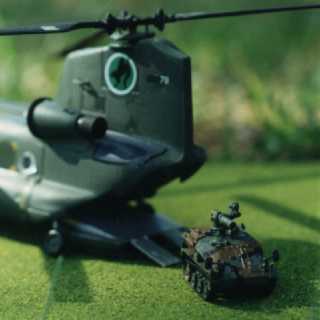
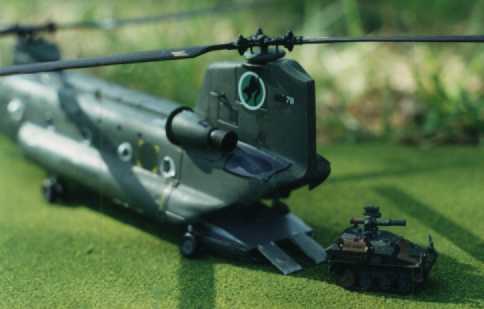
WIESEL PHOTO GALLERY!
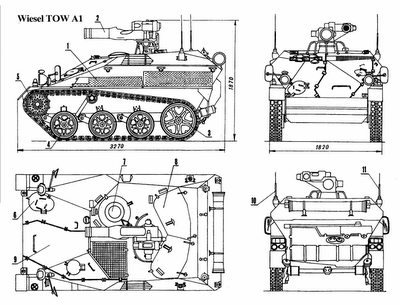
Photographs
Wiesel 2 with infantry
Wiesel 1s by a CH-53G
Wiesel 1 sling-loaded by a UH-60L Blackhawk
Wiesel 1 climbing a hill!
Wiesel 1 by helicopter
Wiesel with Mast Mounted Sight for reconnaissance
Wiesel in traffic! on civilian paved roads
Wiesel 2 in CH-53G interior view
Wiesel roll onto C-130 Hercules STOL aircraft
Wiesel 1 in Somalia behind sand bags
Wiesel 2 rolling off CH-53G helicopter
Wiesel 1 by Wiesel 2 with CH-53G
Wiesel 1 and Wiesel 2 close-up
Wisel 1 by M113G
Wiesel 1 firing TOW ATGM
Wiesel 1 with good camouflage
Wiesel 1 underslung a Puma helicopter
Color paintings
Wiesel 1 20mm side-view
Wiesel 1 20mm rear-view
Wiesel 1 20mm front-view
Wiesel 1 20mm U.N. Somalia mission
Wiesel 1 TOW 3/4s view
Wiesel 1 TOW side-view
Wiesel 1 TOW side-view
CH-53G and Wiesels making bridge for river crossing
Black & White line drawings
UH-60L SEL with Wiesel 2 line-art
Wiesel 2 line art
Wiesel 2 line art no background
Wiesel 1 20mm 3/4 view
Wiesel 1 20mm 3/4 view
Wiesel 1 TOW top-view
Wiesel 1 TOW side-view
Scale Models
Wiesel 1 TOW airlanding with M113A3 Gavin from C-130J Hercules
Wiesels from CH-47D Chinook
UH-60L SEL with Wiesel airlanded
UH-60L SEL with Wiesel front-view
Wiesel 1 20mm top-view
Wiesel 1 TOW close-up
Wiesel 1 TOW Gunner position
Wiesel 1 TOW rear-view
One turret does it all?
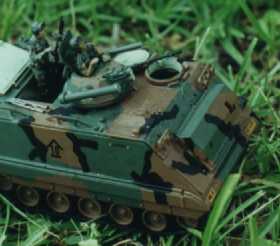

The ASP-30 fires with low-recoil and shock forces such that it can be fired by the crewman unbuttoned---in other words his head can be outside the turret. This is why the ASP-30 is offered as a replacement for the .50 cal HMG on M113A3 TC cupolas. The heavier (unable to fly by Army helicopters) BFV's 25mm M252 high-velocity gun is lethal to friendlies who have their heads out of their vehicles from concussion and noise effects.
The ASP-30 will kill enemy personnel carriers and infantry fighting vehicles as handily as the BFV's 25mm chain gun can, ask AH-64A Apaches pilots from Desert Storm who have the M230 on their aircraft.
The Javelin is a fire/forget missile that has no backblast--its "soft launch". If anyone's head is out when the Javelin fires, no problem. The Javelin can kill tanks from the top-down, enemy helicopters or bunkers as the missile guides itself on the heat signature--the vehicle doesn't have to be stopped and the Gunner tracks the missile all the way to the target. The vehicle can "shoot" and then "scoot" to protective cover or a different firing position.
Both systems would be aimed by a Forward Looking InfaRed (FLIR) sight.
If you look at the picture, you see the pay-off----M113A3, Wiesel 2 and BFV infantry can have the top troop hatch OPENED so they can fire their weapons and give greater vigilance and situational awareness than if they are closed up in the back. If artillery fire is received, everyone "buttons up" and the dismount infantry "see" with a large TV/computer screen now standard equipment on M2A3 BFVs. Both the 30mm and the Javelins can be fired without risk of infantry in the back being harmed as the "blind" BFV set-up has us now. We make the M113A3 and the Wiesel 2 as the baseline vehicles for the Army's new BCTs and equip them with 30mm/Javelin turrets.
The German Fallschirmjaegers are using Wiesels en masse' for amazing operational effects like their Panzer forebears did in 1940 France with light tanks supposedly "inferior" to Allied heavier tanks like the Somua 35. An excellent description of the German Airborne Anti-tank battalion using the Wiesel AFV is by LTC Wolfgang Mettler in the Jan-Feb 1995 issue of Infantry magazine, pages 24-29. The Wiesel 2 can carry 5 infantrymen in the back in addition to its Track Commander and Driver. The Wiesel 2 can also fire a 120mm heavy mortar system and be used as a mobile Air Defense Artillery (ADA) "Ozelot" weapon.

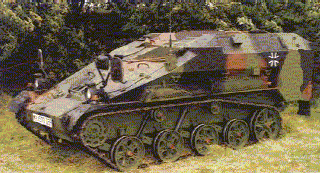
Awesome Wiesel 2 can hold 7 men inside!
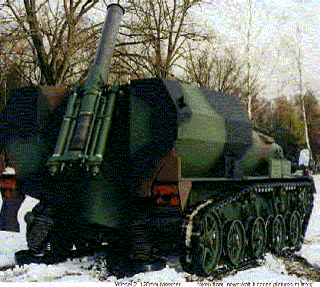
U.S. Caterpiller/German MaK Maschinebau GmbH (Manufacturer of the Wiesel Airborne light tank)
D2300 Kiel 17
P0B. 9009
Tel (0431) 3811
http://www.army-technology.com/contractors/armoured/mak/index.html#mak3
Both the "All Americans" and the "Screaming Eagles" would tow EFOGM-trailers behind M113A3 Gavins and Wiesels to effect a long-range extended fire capability. We can achieve an AIRmotorized capability NOW by sling-loading HMMWVs to transport 2 infantry rifle platoons and an EFOGM platoon using plentiful UH-60L Blackhawks helicopters in the 101st Air Assault Division. This would begin to demonstrate to planners the tactical and operational opportunities that combining AIR and ground vehicle mobility create.
Once a force of 50-100 Wiesel 2s are in service with the 101st Air Assault Division (sling-load), and about 50 x M113A3s in the 82d Airborne Division (airdrop), an interim AIRmechanized war fighting capability would be operational until the FCS/AMV (objective) is fielded. One war fighting enhancement for the Blackhawk and Chinook would be a pod or a Streamlined External Load (SEL) kit to carry the Wiesel 2 or Gavin AFV close to the fuselage to reduce drag and swinging so they can fly at full flight profiles/speeds:



These low-cost SEL enhancements coupled with wings, more powerful engines and better rotor systems can keep the current UH-60L/CH-47F/G fleet combat effective until the FTR arrives in the 2015-2020 time frame.
For a more detailed CASS 3-style "staff study" of why small tracked AFVs are far superior to large, inefficient wheeled armored cars:
http://www.geocities.com/smallafvsstudy.htm
AIRMECH!
FEEDBACK!
"A Couple of random thoughts (it was a long plane ride home)... What are your thoughts on resupply ops, particularly Class III? If the intent is to move a BN of these creatures forward up to 300K, it could be a nightmare.
Y and I argued this point extensively. His take was that a CH-47 could be configured to carry a JP-8 blivet and pumping unit. That brings up two COA for refueling ops - neither attractive:
1. Park the bird behind the lines and do service station ops.
2. Send the bird forward to each BP to do tailgate ops.
COA 1 requires the trigger-pullers to thin the lines and refuel by element - not a good choice when deep in bad guy territory. Also creates excessive movement, noise, etc. Bird would also be exposed for quite a while.
COA 2 while better for the guns is worse for the bird. Way too much exposure.
A possible solution is to rig a Hummer with a 250 gallon fuel pod. Going off a guess that either the Gavin or the Ridgway has a 15-20 gallon fuel tank, one of these Hummers could fully resupply a company.
Advantages:
1. Fuel forward (with less signature than a CH-47)
2. Keeps trigger-pullers on the line.
3. By dropping a 2000-gallon blivet in the trains, the Hummers could move back and forth along the MSR.
4. If one gets blasted, its about $12 million cheaper to replace than a CH-47.
Just some thoughts..."
CPT X
REPLY 1:
"Sir,
I would like to point out that option 2 (Send the bird forward to each BP to do tailgate ops.) is not a good idea for most AMS (or any other) units. In my less than humble opinion, you might as well put sirens and flashing lights on maneuver units if you are going to land CH-47s close by. I like the idea of a fuel blivet carried by a CH-47, however you make some big assumptions (or maybe none) about your enemies ability to respond when you do this (artillery? Mortars?).
Anyone who knows what to look for would have no trouble finding a Bde or Div. HQ by the helicopter traffic alone. It's not wise to make enemy recon units look smart. We made the NVA/VC look very smart with our regular helicopter resupply. If, "all war is based on deception" then our logistic practices in Vietnam were not a good way to go and we should not make this same mistake again."
AMS-SG staff member 1
REPLY 2:
"Men,
We are looking at clandestine refueling like its a major unit operation.
COA 3 is to carry extra fuel in 5 gallon cans strapped to the outside of the Wiesel 2 (Swedish S-Tank style) or all towed in a trailer.
2 x Wiesel 2s (we call them Ridgway Fighting Vehicles) would deploy at a time for scout missions with dismount scouts and folding (All-Terrain Bikes) ATBs. Its also possible to have 2 ride in diesel-powered ATVs, also. When they are airlanded forward by a helicopter (2 UH-60Ls or both by one CH-47D) they arrive at the Named Area of Interest (NAI) with full full tanks. This means with the Wiesel 2's superb 7-13 mpg use rate, their 20.9 gallon tanks, they have a minimum range of 140 miles to a maximum of 200 miles on INTERNAL FUEL.
Let's take the "middle" figure.
Wiesel 2 AFV 8 hours @ 20 mph = 160 miles = Needs 20.9 gallons to fill up tank daily
MAGNITUDE OF THE PROBLEM IS SMALL
That's only 4 x 5 gallon cans of diesel/JP-8 per Wiesel 2.
These can be strapped to the outside rear of the Wiesel 2 or carried inside a trailer one of the Wiesel 2s tows for clandestine refueling.
The RFV RSTA unit operating forward should not need a noisy helicopter to refuel it because:
1. It can easily carry an entire refueling in 5 gallon cans
2. It should not be forward of the FLOT beyond its overland
driving range to get back to friendly lines
3. Friendly troops should advance forward to link-up and ground refuel them and/or pick them up by helicopters to bound forward again
COA 4: freedrop 5-gallon POL cans (Worse-case scenario)
If the RFV RSTA unit needs fuel, operating in pairs, UH-60Ls can do "dummy" insertions to keep the enemy offguard to their real link-up site. Then, when the real site is arrived at, the UH-60L crew chief pushes out 4 sets of 2 x 5-gallon fuel cans with honeycomb on their bottoms and a poncho-parachute to keep them upright to land on the shock absorber, then the helo flies off to do more dummy insertions before leaving. The RSTA (Squad) pair sends its scouts forward on their folding ATBs, they each strap a 5 gallon can to the left and right rear panniers of their bikes and then push them back to their Wiesel 2 RFVs in covered/concealed hide positions, with scouts not pushing ATBs ready to fire their weapons.
Airborne!"
AMS-SG Staff Member 2